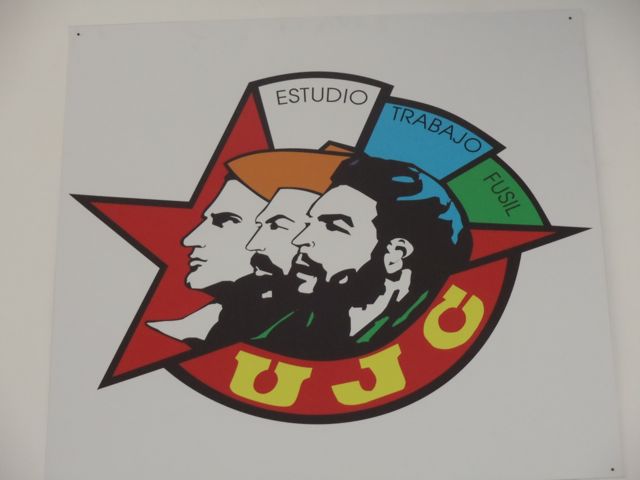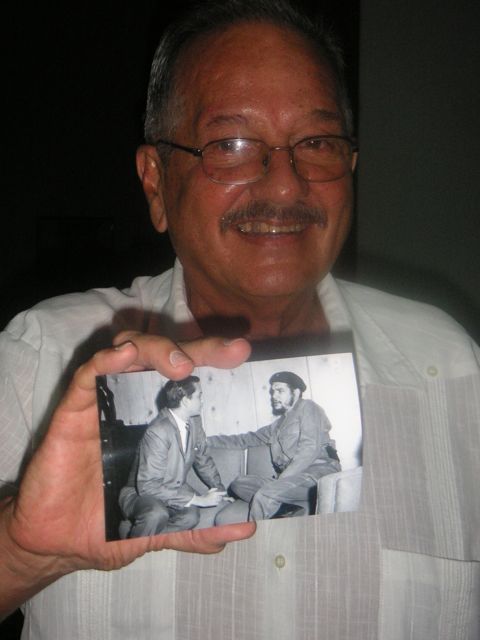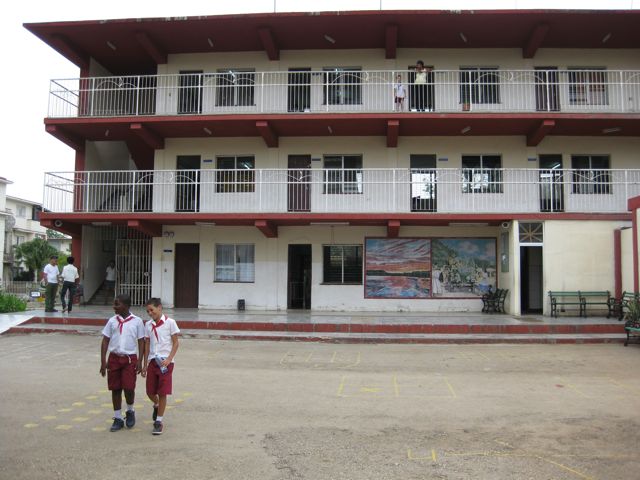Estudio, Trabajo, y Fusil
Study, Work and Defend! This slogan, noted on a sign upon our entrance into the National Trade Union Center of Cuba, set the tone for our travel and study today. A day filled with the examination and discussion of the Cuban educational system, the rights of the worker (specifically related to the field of Education), and the role schools play in fostering a national identity (including a clear understanding of Cuban history and common cultural values). A thread running throughout all our visits today (and throughout this trip) seems to be the concept of “transformation”—and the recognition that systems in Cuba are constantly being transformed.
TRABAJO…Our day began with a meeting with Diosdada Vidal Valle, a very informative and passionate representative of the Asociacion Cubana de Pedagosos (Association of Cuban Educators), a trade union focused specifically on the interests of trade workers in Education, Science and Sports. This trade union represents a grassroots, bottom-up effort to represent and defend the rights of the workers. The conversation focused on the structural organization of schools at the municipal, provincial, and national level. Union membership includes teachers, administrators, members of the Ministry of Higher Education, trade workers manufacturing educational materials, and members of the scientific research community. While it is not compulsory to belong to the union, 97% of all potential workers do and pay dues of one percent of their annual salary. In many ways, the model of this union mirrors those of educational union systems in the United States in both structure and purpose—varying primarily by categories of membership—specifically noting that school administrators and members of higher education institutions are not part of the U.S. system.
The structure of Cuba’s educational system was also of interest to the group. Children attend primary (grades 1-6) and then secondary school (grades 7-9). At the culmination of the ninth grade students face an educational fork in the road where they take a series of required exams and are asked (or advised) to identify a career-path leading either to pre-university studies or technical studies/training. Interestingly, the number of spaces available at the pre-university level is based upon the needs of the State. Valle noted that as more trade technicians are needed in some municipalities, fewer pre-university spaces are available and the requirements for entrance into these programs is more competitive, thus redirecting many students into technical tracts. This caused many in the group to wonder about the option of choice in selecting one’s path of training for his/her professional career. Thus, while education provides a means for transformation of the child into a worker, the system in and of itself is also under ongoing transformation.
One point of discussion that was of particular comparative interest to many in our group was the role that parents play in the daily operation of the school. Parent organizations have an official representative role that informs school policy. Contrary to common practice in the United States, Cuban parents appear to be more actively engaged in their involvement with the schools in authentic and ongoing ways as they are held accountable by other parents and the students for their regular participation in school activities. We did note that in both the Cuban and U.S. schools, parent involvement is valued as a key element in the success of each child and a given school.
FUSIL…“In order to understand Cuba today, one must understand its history. Prior to the revolution, infant mortality was high, unemployment was high, citizens did not have free access to education, health care, or sports, prostitution was rampant and people were ready for the revolution…..” This was the message of the Head of the North American Division. This visit, which took us to a beautifully renovated and once opulent home, now serving as the offices of ICAP. His role was to explain a bit more about the history of Cuba and some of the assets that Cuba has including human capital. He welcomed us to Cuba, stressing the need for solidarity between Cuba and the United States. In recognition of “transformations” taking place in Cuba.
ALBA
To develop, to work with, and to keep relationships with North American countries.
“In order to understand Cuba today, one must understand its history. Prior to the revolution it is important to note that infant mortality was high, unemployment was high, citizens did not have free access to education, health care, or sports…..”
We have been a country able and willing to share with those who have less…
Cuba Five
ESTUDIO…All Cubans have access to free education that includes university level or technical training, depending on a student’s performance through grade nine and the needs of the municipality. With study in mind, our final “field trip” of the day took us to a local elementary school where we met with the Assistant Director, Boris. We wandered in and out of first through sixth grade classrooms, each grade differentiated by the color of scarf worn with the uniform. The school grounds were surrounded by a locked, chain-link fence and included a three-story, open air concrete building, an asphalt schoolyard complete with many games (hopscotch, four-square, twister), a “Marti” garden (replicating vegetable plants planted by Jose Marti upon his arrival in Cuba), a large cafeteria, and murals depicting Cuban heroes. Each classroom was named for a national hero and contained study materials related to that specific hero. Uniform in size and overall appearance, these small classrooms had a row of desks for the 20 children each dressed in identical uniforms with color-coded kerchiefs identifying their grade level, a television and a VCR, an alphabet strip, one small bookshelf with a few teaching materials, and a row of blackboards, each with the current date AND the number of years since the revolution written on it. Each child had a composition book on his/her desk and eagerly greeted us with waves, smiles, and some interesting questions, the first which took all of us by surprise…”Are they killing people in the U.S.?” These children obviously watch TV and are influenced by media coverage of events in the U.S. A first grader proudly displayed a patch on his left should indicating “I can read,” as with other children. Not to be outdone, another child was quick to let is know that he too could read but had lost his patch.
When asked about the goals of the school, the Assistant Director emphasized the need for more parent involvement, teaching materials, morality training, and trained teachers. When asked what “transformations” are currently taking place in the schools, Boris noted the recent downsizing of classrooms (from 25 to 20 students), the inclusion of English instruction (Russian was taught until the early 1990’s), the addition of a TV and VCR in every classroom, the increase in teaching Cuban history, and a bank of computers in each school.
At the end of a long day, we appreciated the good food, our fabulous guide, and the shot of a cannon, staged to recreate the warning to Colonial-era Havana inhabinants that the gates to the wall around the city were being closed! We found it hard to believe that we stood in Che’s office while Dr. Manuel Yepe, a pre-eminent Cuban scholar, who regaled us with stories of his own experiences with Che and during the counter-revolution. with a man who served as his Director of Protocol. Referred to as a “walking museum” or “The Professor” Dr. Yepe added much life to Cuban history.
We continue to eat beans and rice (today’s was the best so far), move to the music (some better than others), marvel at the sense of community among the people we’ve met, and, of course, sweat (a the few among us do it so well).
Megan and Alison































5 replies on “Day 4”
Viagra fiyat
Hales Fund 09-10 » Blog Archive » Day 4
useful content
Hales Fund 09-10 » Blog Archive » Day 4
aaa rolex china watch
Hales Fund 09-10 » Blog Archive » Day 4
Social Network Marketing Strategy
Hales Fund 09-10 » Blog Archive » Day 4
Fonte
Hales Fund 09-10 » Blog Archive » Day 4